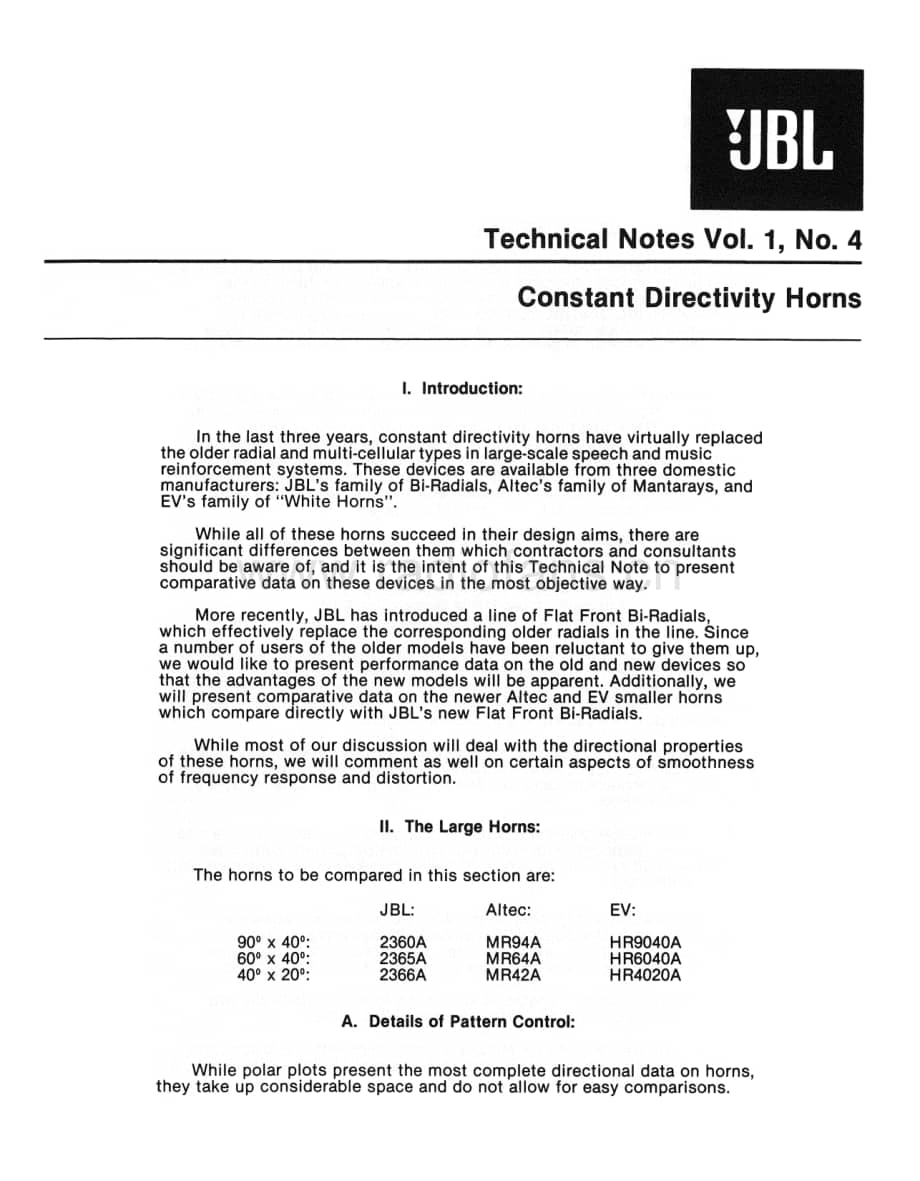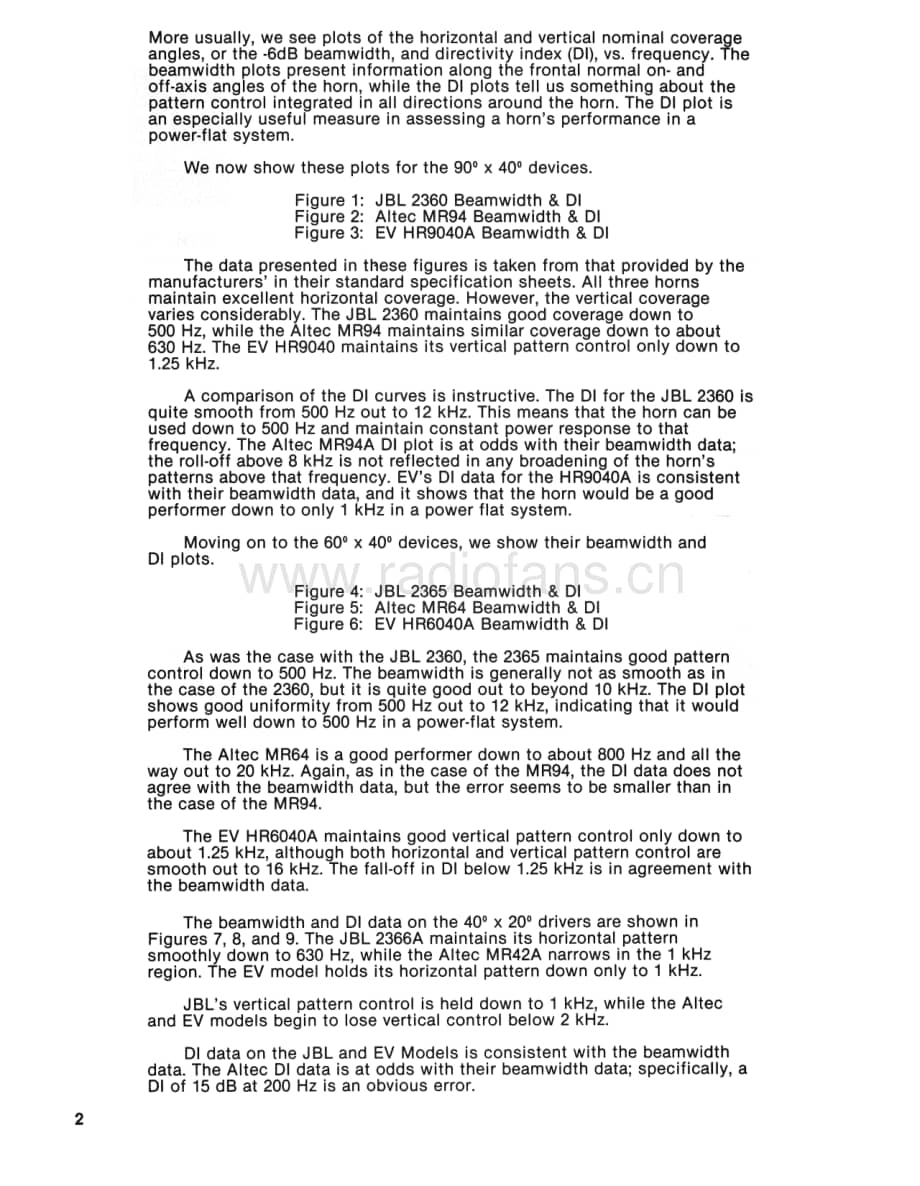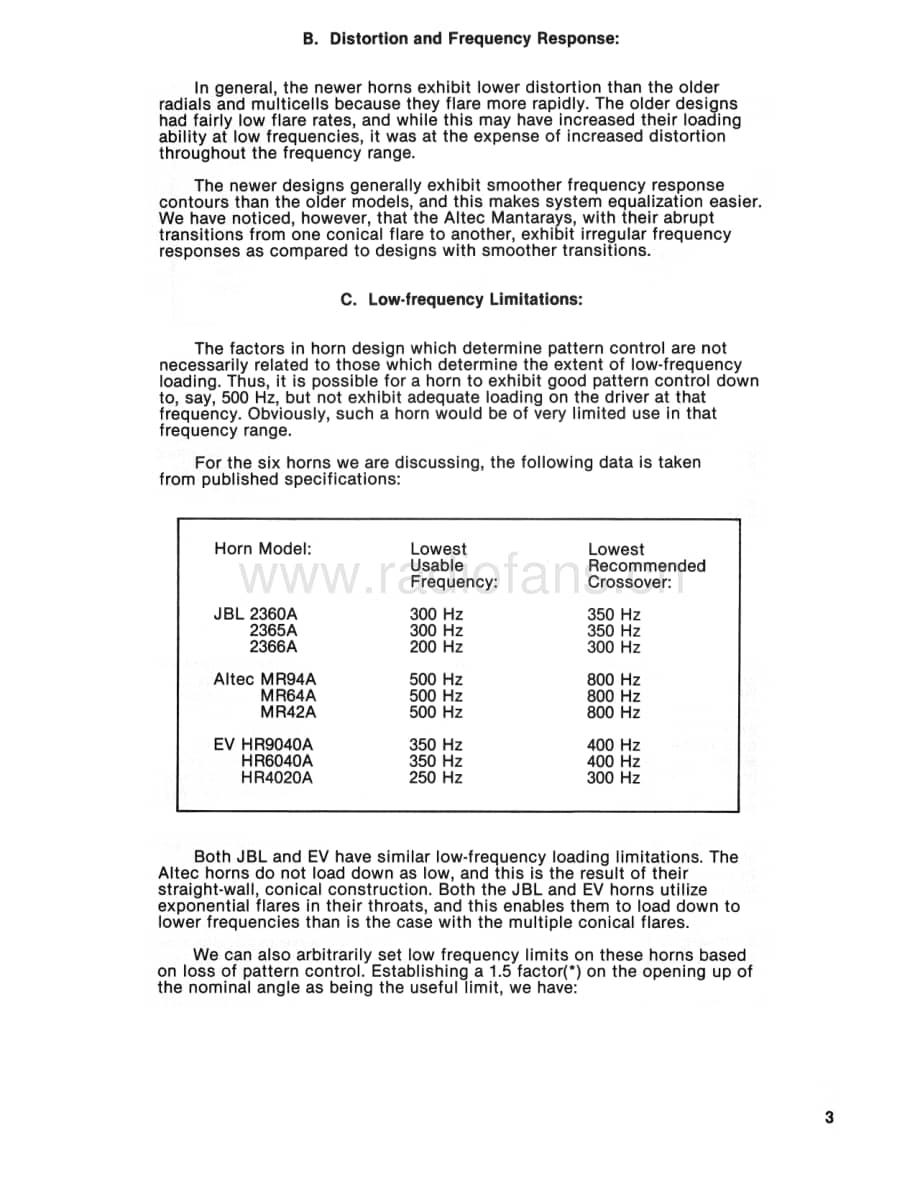 JBL Technical Note - Vol.1, No.4 电路原理图.pdf
JBL Technical Note - Vol.1, No.4 电路原理图.pdf
《JBL Technical Note - Vol.1, No.4 电路原理图.pdf》由会员分享,可在线阅读,更多相关《JBL Technical Note - Vol.1, No.4 电路原理图.pdf(12页珍藏版)》请在收音机爱好者资料库上搜索。
1、Technical Notes Vol. 1, No. 4 Constant Directivity Horns L Introduction: In the last three years, constant directivity horns have virtually replaced the older radial and multi-cellular types in large-scale speech and music reinforcement systems. These devices are available from three domestic manufa
2、cturers: JBLs family of Bi-Radials, Altecs family of Mantarays, and EVs family of White Horns. While all of these horns succeed in their design aims, there are significant differences between them which contractors and consultants should be aware of, and it is the intent of this Technical Note to pr
3、esent comparative data on these devices in the most objective way. More recently, JBL has introduced a line of Flat Front Bi-Radials, which effectively replace the corresponding older radials in the line. Since a number of users of the older models have been reluctant to give them up, we would like
4、to present performance data on the old and new devices so that the advantages of the new models will be apparent. Additionally, we will present comparative data on the newer Altec and EV smaller horns which compare directly with JBUs new Flat Front Bi-Radials. While most of our discussion will deal
5、with the directional properties of these horns, we will comment as well on certain aspects of smoothness of frequency response and distortion. II. The Large Horns: The horns to be compared in this section are: JBL: Altec: 90 x 40: 60 x 40: 40 x 20: 2360A 2365A 2366A MR94A MR64A MR42A HR9040A HR6040A
6、 HR4020A A. Details of Pattern Control: While polar plots present the most complete directional data on horns, they take up considerable space and do not allow for easy comparisons. More usually, we see plots of the horizontal and vertical nominal coverage angles, or the -6dB beamwidth, and directiv
7、ity index (Dl), vs. frequency. The beamwidth plots present information along the frontal normal on- and off-axis angles of the horn, while the Dl plots tell us something about the pattern control integrated in all directions around the horn. The Dl plot is an especially useful measure in assessing a
8、 horns performance in a power-flat system. We now show these plots for the 90 x 40 devices. Figure 1: JBL 2360 Beamwidth the roll-off above 8 kHz is not reflected in any broadening of the horns patterns above that frequency. EVs Dl data for the HR9040A is consistent with their beamwidth data, and it
9、 shows that the horn would be a good performer down to only 1 kHz in a power flat system. Moving on to the 60 x 40 devices, we show their beamwidth and Dl plots. Figure 4: JBL 2365 Beamwidth specifically, a Dl of 15 dB at 200 Hz is an obvious error. 2 B. Distortion and Frequency Response: In general
10、, the newer horns exhibit lower distortion than the older radials and multicells because they flare more rapidly. The older designs had fairly low flare rates, and while this may have increased their loading ability at low frequencies, it was at the expense of increased distortion throughout the fre
11、quency range. The newer designs generally exhibit smoother frequency response contours than the older models, and this makes system equalization easier. We have noticed, however, that the Altec Mantarays, with their abrupt transitions from one conical flare to another, exhibit irregular frequency re
12、sponses as compared to designs with smoother transitions. C. Low-frequency Limitations: The factors in horn design which determine pattern control are not necessarily related to those which determine the extent of low-frequency loading. Thus, it is possible for a horn to exhibit good pattern control
13、 down to, say, 500 Hz, but not exhibit adequate loading on the driver at that frequency. Obviously, such a horn would be of very limited use in that frequency range. For the six horns we are discussing, the following data is taken from published specifications: Horn Model: Lowest Usable Frequency: L
14、owest Recommended Crossover: JBL2360A 300 Hz 350 Hz 2365A 300 Hz 350 Hz 2366A 200 Hz 300 Hz Altec MR94A 500 Hz 800 Hz MR64A 500 Hz 800 Hz MR42A 500 Hz 800 Hz EV HR9040A 350 Hz 400 Hz HR6040A 350 Hz 400 Hz HR4020A 250 Hz 300 Hz Both JBL and EV have similar low-frequency loading limitations. The Altec
15、 horns do not load down as low, and this is the result of their straight-wall, conical construction. Both the JBL and EV horns utilize exponential flares in their throats, and this enables them to load down to lower frequencies than is the case with the multiple conical flares. We can also arbitrari
16、ly set low frequency limits on these horns based on loss of pattern control. Establishing a 1.5 factor(*) on the opening up of the nominal angle as being the useful limit, we have: 3 Horn Model: Pattern Control Limits Horizontal: Vertical: JBL 2360 200 Hz 500 Hz 2365 400 Hz 500 Hz 2366 630 Hz 1 kHz
17、Altec MR94 300 Hz 630 Hz MR64 400 Hz 630 Hz MR42 400 Hz 800 Hz EV HR9040A 200 Hz 1.2 kHz HR6040A 400 Hz 1.2 kHz HR4020A 300 Hz 1.2 kHz *No greater than 30 for 20 nominal No greater than 60 for 40 nominal No greater than 90 for 60 nominal No greater than 135 for 90 nominal One point is clear from an
18、inspection of the data presented thus far, and that is that the JBL 2360 and 2365 horns are the only ones of the group that can be specified for use down to 500 Hz with negligible loss of both horizontal and vertical pattern control and with proper driver loading. Again, we stress that the data we h
19、ave been examining is that provided by the manufacturers themselves on their own products. ill. The Small Horns: A. A Quick Look at the Old Radials: Most of the radial horns which were the workhorses of the professional sound business for decades were designed back in the forties and fifties. When v
20、iewed from above, they appear as sectors of a circle bounded by radii on the sides; when viewed from the side, they appear as a simple exponential flare, as shown in Figure 10 (A) and 10 (B). If the flare development in the throat is carefully derived, then the radial horn will exhibit quite even ho



- 配套讲稿:
如PPT文件的首页显示word图标,表示该PPT已包含配套word讲稿。双击word图标可打开word文档。
- 特殊限制:
部分文档作品中含有的国旗、国徽等图片,仅作为作品整体效果示例展示,禁止商用。设计者仅对作品中独创性部分享有著作权。
- 关 键 词:
- JBL Technical Note Vol.1 No.4 电路原理图 Vol No 电路 原理图
 收音机爱好者资料库所有资源均是用户自行上传分享,仅供网友学习交流,未经上传用户书面授权,请勿作他用。
收音机爱好者资料库所有资源均是用户自行上传分享,仅供网友学习交流,未经上传用户书面授权,请勿作他用。



 Marshall-9100-62-02-Schematic电路原理图.pdf
Marshall-9100-62-02-Schematic电路原理图.pdf
 Fisher_51PL 维修电路图 原理图.gif
Fisher_51PL 维修电路图 原理图.gif
 eaw8176e 维修电路图 原理图.jpg
eaw8176e 维修电路图 原理图.jpg
 AIWA HS-J2 电路图 维修原理图.png
AIWA HS-J2 电路图 维修原理图.png


